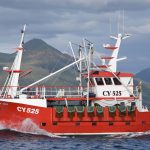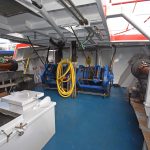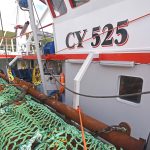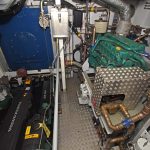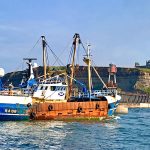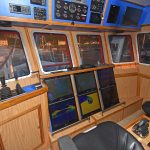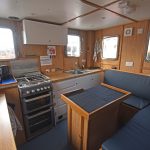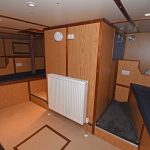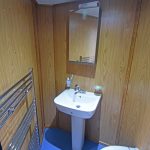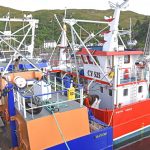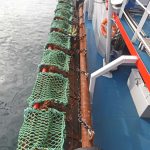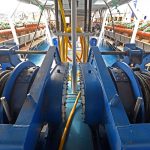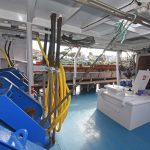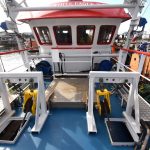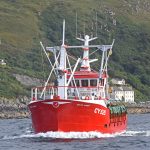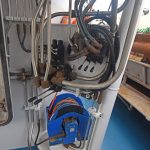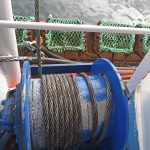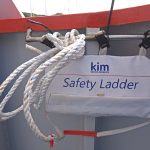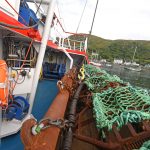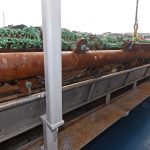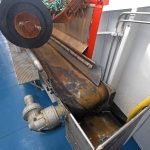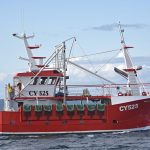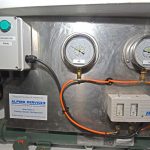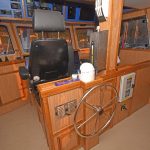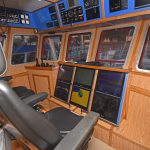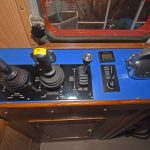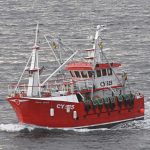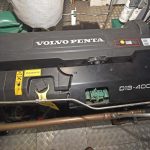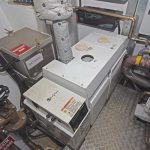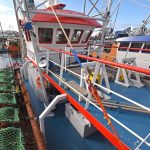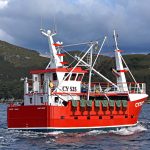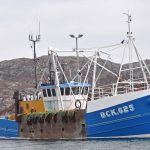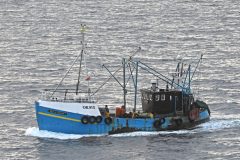Multi-company teamwork contributes to customised vessel design and working arrangements
The new North Uist scalloper White Eagle CY 525 started fishing from Kallin harbour last week, after being built in Cornwall for brothers Konrad and Kamil Kosieradzki, reports David Linkie
Designed by SC McAllister & Co Ltd and built at Polruan by C Toms & Son Ltd for K&K Fishing Ltd, the 14.95m White Eagle incorporates a number of interesting ideas designed to give enhanced levels of working efficiency, safety and comfort.
Standout features include:
- Running the main wires over the top of the central shelterdeck walkway
- Fuel wing tanks built into the sides of the fishroom amidships
- A forward engineroom
Leading the 24mm Gold Beam trawl wires, supplied by Tyson’s Ships Riggers, upwards from the forward split trawl winches to run over the top of the shelterdeck, and outboard to hanging blocks mounted on conventional towing arms, both maximises the amount of space and enhances safety on the main deck.
Locating the deep fuel tanks between the sides of the hull and the fishroom ensures that White Eagle remains on a constant even trim during a trip, with the increasing catch weight compensating for the amount of fuel used.
The forward engineroom meets the owners’ requirement to minimise ambient noise levels throughout the accommodation areas, including the wheelhouse, where tests recorded a sound level as low as 50 decibels.
Catch quality and handling efficiency on White Eagle are promoted by the presence of outer hull tipping doors and side conveyers, which move the contents of the eight-a-side dredges forward for selection under the whaleback.
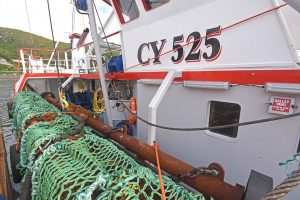
White Eagle works eight dredges a side.
White Eagle proudly takes its name from the stylised white eagle, with a golden beak and talons, and wearing a golden crown, in a red shield, depicted in Poland’s national coat of arms. The white eagle emblem originated when Poland’s legendary founder Lech saw a white eagle’s nest. When he looked at the bird, a ray of sunshine from the red setting sun fell on its wings, so they appeared tipped with gold; the rest of the eagle was pure white.
In addition to the designer and builder, a number of well-known firms from as far afield as Macduff and Brixham made significant contributions to the construction and fit-out of White Eagle.
The vessel’s scallop gear came from a similarly wide area, including Devon, Dumfriesshire, Grimsby and Oban.
White Eagle is the first new boat to be built by C Toms & Son Ltd for owners in Scotland since it delivered the 12.73m wooden-hulled prawn trawler Eilidh BRD 149 to Kyle of Lochalsh skipper Donald Mathieson in 2001.
Replacing the owners’ previous vessel, the 18m Kelly BCK 625, White Eagle is expected to follow similar fishing patterns, landing every two to three days and generally fishing in the Minches between the Outer Hebrides and northwest Scotland.
Insured by Sunderland Marine and sailing with a crew of three, White Eagle will continue to land king scallops locally to Kallin Shellfish, with which Konrad and Kamil Kosieradzki have a longstanding association spanning more than 10 years.
By coincidence, when White Eagle called into Mallaig for a few hours, during the scalloper’s otherwise non-stop delivery trip of some 700 miles from Polruan to Kallin, she tied up alongside Kallin Shellfish’s recent acquisition Silver Fern CY 197 (Fishing News, 15 August). The two scallopers made a fine sight and demonstrated a strong statement of intent for everyone associated with the Outer Hebrides.
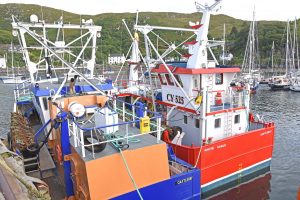
White Eagle berthed outside Silver Fern at Mallaig – the two new scallopers represent a major boost for the Western Isles.
During the brief stop at Mallaig, which enabled Bertie McMinn of Western Battery Service to set up White Eagle’s WASSP multibeam sonar, skipper Konrad Kosieradzki said: “The true tests of White Eagle’s capabilities are still to come. Hopefully these will prove successful, and we will settle into an efficient way of working.
“Initially, a fairly steep learning curve lies ahead, as was the case when we replaced Stelimar with Kelly. Ultimately this proved beneficial, which we hope will be the case again.
“Vessel design and machinery technology continue to advance at a rapid rate. White Eagle is designed to be an economical boat to run, in terms of both main and auxiliary power requirements. While the initial signs are encouraging, it will be some time before these are fully evaluated.
“Everyone involved with the construction of White Eagle has contributed to the end result, the standard of which speaks for itself. Building any new boat is a long-term project, and now it’s down to us to deliver.”
Incorporating a bulbous bow and a box keel for ballast, White Eagle’s double chine hull has main dimensions of LOA 14.95m, registered length 14.36m, beam 6.72m, moulded depth 2.66m, draft 3.6m and tonnage 41.07t.
The steel whaleback is continued aft to the aluminium wheelhouse by a central shelterdeck walkway, thereby leaving the vessel’s sides open to work the scallop dredges.
Internal layout below the main deck from forward consists of forepeak tank, engineroom, hold, and four-berth accommodation cabin/steering gear compartment.

A Cummins 22.5 MDKDT 28.1kVA genset is housed in a soundproof cabinet.
A watertight door, situated to starboard of the scalloper’s centreline, gives access off the main deck into the central deckhouse, the forward corners of which are angled to provide maximum deck space for the pulling-down winches to be mounted on the main deck. Leading to the galley/messdeck area, which is arranged across the full width of the deckhouse aft, the passageway also gives access to a spacious shower and toilet compartment positioned in the forward port corner, and the wheelhouse companionway to port.
Four berths, two parallel to the transom and two to the sides of the hull, are arranged either side of the compartment housing the Wills Ridley steering gear.
All the internal accommodation areas on White Eagle have been completed to a high level of finish by C Toms & Son Ltd.
Fishing arrangements
Scalloping activity on White Eagle is centred on two split trawl winches, designed and manufactured by Macduff Shipyards Ltd. Rated at 9t, the winches have a capacity for 200 fathoms of 24mm trawl wire.
From the winch, the wires lead upwards at 45° through elongated openings in the shelterdeck walkway to hanging blocks slung on robust steel box-section saddles. Supplied by F&R Belbin of Whitley Bay, the distinctive yellow-painted Flemings Fairleads blocks are positioned above the shelter to lead the wires aft to a second set of sheaves positioned at the forward corners of the wheelhouse, before angling outboard to hanging blocks on the traditional spreaders aft.
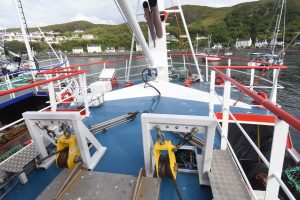
The saddle-mounted hanging blocks viewed from aft.
Of box-section construction, the towing arms are pivoted at main deck level at the aft end of the deckhouse. Raised and lowered by ropes worked from the pulling-down Gilsons, the towing arms slot into secure holding brackets welded on top of the gunwale rail.
Konrad and Kamil Kosieradzki specified working the wires over the top of the shelterdeck in order to maximise crew safety on the main deck. This arrangement also contributes significantly to the considerable amount of working space and good access available on the main deck. That this has been achieved while incorporating catch-handling conveyers shows the extent to which the owners, designers and builders have used the space available to optimum effect.
Two box-section crutches positioned between the main and shelter decks ensure that the scallop beams and dredges are kept clear of the side decks at all times.
Two 5t Gilson winches are mounted on the strongly braced steel shelterdeck, adjacent to the legs of the goalpost-style lifting gantry amidships. Two 2t pull-down winches are positioned on platforms near the heel of the box-section goalpost-style lifting gantry.
Half-tonne tipping winches, which will be mainly used when changing over dredges at sea during a trip, are mounted on short derricks towards the top of the main lifting gantry.
All items of deck machinery, including the outer hull tipping doors, can be operated from port and starboard consoles in the wheelhouse, as well as from well-protected stations positioned between the deckhouse and the lifting gantry amidships.
On being lifted to the 8m section of straight gunwale rail amidships, the eight-a-side dredges are tipped by a fully automated gear- and catch-handling system, designed to considerably reduce the crew’s workload and enable the vessel to fish with maximum efficiency and safety.
Hydraulically operated outer hull tipping doors, which are widely used by modern scallop vessels, lie at the heart of the automated system.
Fitted into recesses along the vertical sides of the shelterdeck, these extend for more than half of the vessel’s length. Pivoted at shelterdeck level, these self-tipping doors are raised by hydraulic rams mounted just inboard of the scuppers on the main deck, and angled upwards through the recessed sides of the shelterdeck.
The outer hull steel doors were fabricated by Stride Engineering of Brixham, before being delivered to Polruan for installation on White Eagle. The doors are operated by two sets of hydraulic rams, supplied by Macduff Shipyards.
White Eagle’s extensive stainless steel piped hydraulic system was designed and fitted by engineers from Macduff Shipyards, working in liaison with Hercules Hydraulics of Paignton, which also supplied the associated pumps and control valves.
On hauling, the scallop bars are positioned along the top outer edge of the catch hoppers, with the full dredges hanging down outboard. Metal teeth on the outer face of the doors engage in the extended bellies of the scallop dredges to hold them in position against the door as they are swung upwards through 170° to invert the dredges. Rocking the doors either side of vertical allows the contents of the dredges to fall into the reception hopper that extends the length of the scallop bars. After emptying, the raised side panels are lowered back into their recesses on the outside of the hull, allowing the gear to be shot away as usual.
A hydraulically operated slow-moving conveyor runs forward along the bottom of each stainless steel hopper. Like the tipping doors, these were manufactured by Jason Stride and his team at Brixham.

Side reception hoppers and conveyors move the contents of the scallop dredges forward…
Driven by hydraulic motors, with right-angle gearboxes so as not to protrude beyond the line of the hoppers, the heavy-duty rubber conveyors move king scallops and stones forward on either side of the main deck, where a crewman standing under the whaleback picks off selected clams and places them into baskets, before stones drop off the belts back to the seabed via chutes leading out through the sides of the vessel.
After washing, baskets of selected scallops are transferred through a small hatch incorporated in the main fishroom hatch down into the hold for bagging, prior to being stacked against the aft bulkhead.
Fully lined and insulated by the yard, inboard of the fuel tanks that extend the full length of the hold, the square-shaped fishroom, which has an estimated working capacity for some 300 30kg bags of scallops, features deck- and bulkhead-mounted chilling systems installed by Alpino Services.
Engineroom
White Eagle is powered by a Volvo Penta D13 engine, derated to deliver 221kW @ 1,800rpm, coupled to a Masson Marine 7.7062:1 reduction gearbox to turn a 1,800mm-diameter four-bladed skewed Kaplan propeller in a fixed nozzle. This centreline combination, together with the water-cooled stern gear, returned an average top speed of nine knots when White Eagle ran engine trials off Polruan. The steering benefits associated with a triple rudder arrangement, designed by SC McAllister & Co Ltd and fabricated by the yard, were favourably commented on by skipper Konrad Kosieradzki even before White Eagle started scalloping.
Particular consideration was given to ensuring the economical operation of all items of main and ancillary machinery and equipment on White Eagle when drawing up the vessel’s engineroom arrangements.
The scalloper’s main hydraulic system is driven by three Denison pumps mounted on the flywheel end of a variable-speed Volvo Penta D7A auxiliary engine of 130kW @ 1,900rpm.
A standby gear-retrieve hydraulic system is available via a gearbox PTO.
The scalloper’s main engine also drives the catch conveyors via a Dong-I step-up unit, a 210-amp Transmotor and two 110-amp 24V generators, together with the pumps for the Wills Ridley steering gear and the fishroom refrigeration compressor.
Supplied by Marine Engineering (Looe) Ltd, the Volvo Penta D15 main and D7A auxiliary engines are both box-cooled.
A Cummins 22.5 MDKDT 28.1kVA genset, housed in a soundproof cabinet, provides power for equipment used on deck to maintain the dredges and limited onboard socketed outlets. Small items of galley equipment, including the kettle and microwave, are powered by electrical inverters.
Deep wing tanks alongside the sides of the hold amidships, and a daily service tank in the engineroom, carry 12,000 litres of fuel. The side tanks ensure that the gunwale rail and the top edge of the outer hull tipping doors remain level throughout a trip, to retain maximum working efficiency when lifting the scallop gear.
The bulbous bow tank houses 3,000 litres of freshwater.
Scallop gear
A number of well-known English and Scottish companies, with which Konrad and Kamil Kosieradzki have established good working relationships down the years, based on proven product reliability, supplied the eight-a-side scallop gear now being used to good effect by White Eagle.
The dredge frames were manufactured by Oban Scallop Gear Ltd. R&A Fabrication and Engineering Ltd, based in Castle Douglas, Dumfriesshire, supplied the chain bellies. Both companies also supplied tooth bars.
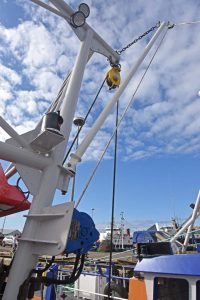
Auxiliary tipping winches and short derricks are fitted towards the top of the Scotch poles.
The scallop beams were fabricated by John Reid & Son of Brixham, which is located in the same Northfields industrial estate where White Eagle’s outer hull tipping doors were made by Stride Engineering.
Tyson’s Ships Riggers supplied 160 fathoms of 24mm-diameter Gold Beam trawl wire, together with the wire for the Gilson and tugger winches.
Well-equipped and well-designed wheelhouse
The effective wheelhouse layout on White Eagle highlights the many hours of forward planning that brothers Konrad and Kamil Kosieradzki put into their new vessel.
The main display screens are centrally arranged in two tiers, forward of two Grammer seats positioned either side of an island console, on which the Simrad AP60 autopilot is fitted.
Slim wing fishing consoles, giving full control of all the main items of deck machinery, are positioned forward to port and on the starboard side aft. Jog steering levers, together with the duplicate Volvo (main) and Kobelt (auxiliary) engine controls, are also positioned at these locations.
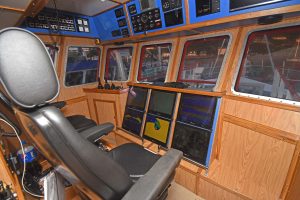
The main forward console.
Seabed mapping duties are performed by a WASSP multibeam sonar system, supplied and commissioned by Bertie McMinn of the Mallaig-based company Western Battery Service Ltd.
Vertical sounding is handled by a JRC JFC-130 dual-frequency (50kHz/200kHz) BB sounder.
This unit, together with most of the other wheelhouse electronics equipment, was supplied by Tecmarine Ltd of Plymouth/Brixham.
The balance of this package includes a Simrad 4G BB radar, two Furuno GP39 GPS receivers, a Simrad AP60 autopilot complete with two follow-up levers, and a JRC JLR-21/31 satellite compass.
Communications equipment includes Simrad RS90S and RS20S VHFs, a Standard Horizon VLH-3000A talkback system and an AMEC Camino 701 Class A AIS.
The owners supplied two MaxSea plotters.
Tecmarine also installed a five-camera CCTV system that provides comprehensive coverage of the engineroom and key working positions on the main deck.
Third scalloper for K&K Fishing Ltd
The delivery of White Eagle is the next step in a steadily progressive course for Konrad and Kamil Kosieradzki, who purchased their first boat 10 years ago.
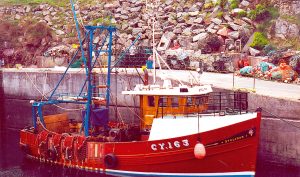
Konrad and Kamil Kosieradzki bought their first scalloper, Stelimar CY 163, in 2007.
This was the 40ft wooden-hulled, transom-sterned and forward-wheelhouse Stelimar CY 163, which they bought from South Uist skipper Iain Johnson. Stelimar was originally built by Herd & Mackenzie at Buckie in 1988 for Duncan and DJ MacRae, at the same time as its sistership Guiding Light CY 127 was in build for Donald and Hector Stewart. The two sets of brothers have run Kallin Shellfish as equal partners since 2000, thereby providing crucially important shellfish-processing capacity and niche markets for premium-quality locally caught shellfish in North Uist.
Stelimar was replaced in 2013 when K&K Fishing bought the 59ft Kelly BCK 625 from James Monnaghan of Islay.
Herd & Mackenzie built the wooden-hulled Kelly BCK 303 in 1983 as a gill-netter for Danbrit Fishing Company of Grimsby. The vessel was subsequently rigged for side-trawling, fishing from Whitby for a time under skipper Arnold Locker. Kelly was later converted for scalloping, during which time the vessel had several owners, prior to being sold to Shetland earlier this summer when White Eagle was nearing completion.
For more new boat features, click here




